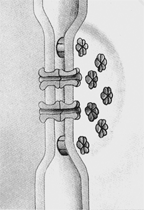The sequence in Figure 52-2 illustrates:a
classical conditioning.
b. habituation.
c. imprinting.
d. insight.
e. operant conditioning
A
You might also like to view...
What metabolic advantage do cells have in storing the elemental sulfur byproduct from sulfide oxidation?
A) The cells avoid producing transport energy waste to secrete the sulfur. B) The byproduct serves as an electron reserve for subsequent oxidation. C) Sulfur decreases the intracellular acidification for non-acid-tolerant sulfide oxidizers. D) The byproduct can be used for other biosynthetic pathways that use sulfur, such as Rieske Fe-S proteins.
The structures in this figure:a
provide anchorage points between adjacent cells.
b. allow the transport of small molecules and ions between adjacent cells.
c. allow passage of materials through intercellular spaces.
d. prevent the passage of materials through intercellular spaces.
e. can only be found in plants.c
You drive a nail into a tree that is 10 feet tall, so that 5 inches of the nail are showing. You come back 10 years later. The tree is now 30 feet tall and only 3 inches of the nail are showing. This is because the tree grows out from
A. the lateral meristem only. B. the apical meristem only. C. both the lateral and apical meristems. D. the root tip. E. the node.
Lysogeny always requires integration of the viral genome into the host chromosome.
Answer the following statement true (T) or false (F)